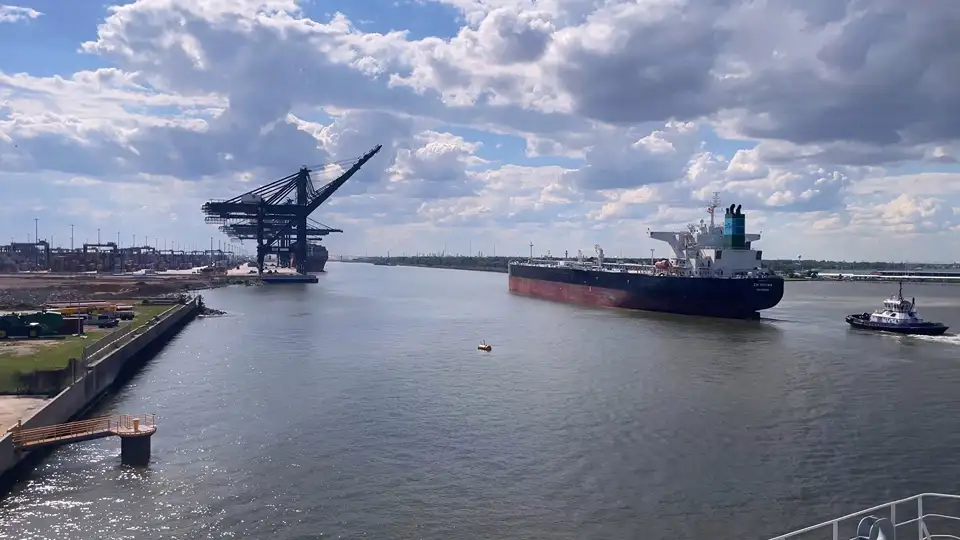Introduction
In a significant achievement for the maritime industry, Port Houston has completed its portion of Project 11, the Houston Ship Channel Expansion. Working alongside the U.S. Army Corps of Engineers (USACE), Port Houston has reached a key milestone, completing major dredging work in Galveston Bay. This collaborative effort represents a crucial step toward improving navigation safety, operational efficiency, and environmental stewardship within one of America’s busiest shipping corridors.
The Project 11 expansion aims to widen and deepen the Houston Ship Channel, ensuring that this vital waterway continues to support the region’s growing maritime and industrial needs.
Project Milestone: Dredging Completion
Construction of channel improvements under Project 11 began in 2022, and Port Houston has now completed dredging the Galveston Bay reach from Bolivar Roads to Morgan’s Point. This phase represents the most significant milestone to date, marking the completion of Port-led navigation-dredging operations.
Port Commission Chairman Ric Campo celebrated the achievement, noting that the success of Port Houston and its partners demonstrates the value of collaboration and the importance of the channel to both regional and national commerce. With the widened channel now open, vessel movements through Galveston Bay will be safer and more efficient than ever before.
Engineering and Operational Impact
The expansion of the Houston Ship Channel under Project 11 widened the waterway from 530 feet to 700 feet through Galveston Bay. This engineering transformation greatly enhances navigational safety, particularly for larger vessels that require greater maneuvering space.
For Port Houston, the benefits are extensive:
- Improved Vessel Flow: The wider channel reduces congestion and transit times for cargo ships.
- Greater Competitiveness: The port’s terminals can now accommodate larger and more modern vessels.
- Enhanced Safety: Increased width and better visibility minimize the risk of collisions in high-traffic areas.
As ships continue to increase in size, this strategic improvement ensures that Port Houston remains a leading hub for global trade, capable of meeting the evolving demands of international shipping and logistics.
Environmental Benefits and Sustainable Practices
Beyond its operational improvements, Project 11 stands out for its strong environmental commitments. Port Houston prioritized beneficial use of dredged materials, ensuring that nearly all sediment from Galveston Bay dredging was repurposed to create or restore natural habitats.
These environmental enhancements include:
- 10 acres of bird islands
- 276 acres of marshland
- 324 acres of oyster reefs
By integrating ecological restoration into the dredging process, Port Houston demonstrates that infrastructure expansion can coexist with sustainability. Additionally, the project contributes to improved air quality; vessel nitrogen oxide emissions are expected to decrease by up to seven percent as a result of shorter transit times and more efficient vessel operations.
To further reduce environmental impact, the dredges used in Project 11 were equipped with Tier 3 and Tier 4 engines or scrubbers, thereby minimizing exhaust pollutants during construction. This aligns with Port Houston’s broader commitment to cleaner operations and long-term environmental responsibility.
Awards and Recognition
The accomplishments of Port Houston and Project 11 have not gone unnoticed. The initiative has earned multiple awards recognizing its engineering excellence and environmental innovation, including:
- The 2025 Environmental Excellence Award from the Western Dredging Association (WEDA)
- The 2025 Outstanding Civil Engineering Achievement Award (OCEA) from the Texas Section of the American Society of Civil Engineers (ASCE)
These honors highlight the success of Port Houston’s balanced approach, advancing economic goals while maintaining a strong focus on sustainability and community value.
Next Phases and Future Outlook
While Port Houston has completed its portion of Project 11, the U.S. Army Corps of Engineers will lead the remaining sections of the channel expansion, scheduled for completion by 2029. The next phases will extend the benefits of the dredging project further along the Houston Ship Channel, enhancing navigational efficiency and economic output across multiple terminals.
Once fully completed, Project 11 will support the continued growth of energy exports, containerized cargo, and other maritime industries, reinforcing the Houston Ship Channel’s position as a global trade powerhouse.
Conclusion
The completion of Port Houston’s portion of Project 11 represents a defining moment in the ongoing evolution of the Houston Ship Channel. By expanding the reach of Galveston Bay and integrating environmental enhancements, Port Houston has advanced both maritime efficiency and ecological sustainability.
As the remaining work progresses under the USACE, Port Houston’s leadership sets a strong example of how infrastructure projects can deliver economic growth, safety improvements, and long-term environmental benefits. The success of Project 11 ensures that the port will remain a cornerstone of America’s shipping future, efficient, competitive, and sustainable.
